How Italy and the US see one another and the world
from the Aspen Italia's Transatlantic Conference
*Davide Angelucci (LUISS) and Gianluca Piccolino (Sant’Anna) coauthored this article
Threat perception
Italians and Americans share the same threat perceptions. The energy crisis is the main perceived threat to both Italian and American citizens. 96% of the Italian respondents and 86% of the American respondents share this view. The second most important threat is the war in Ukraine, perceived as a threat by 94% and 82% of Italian and American respondents, respectively.
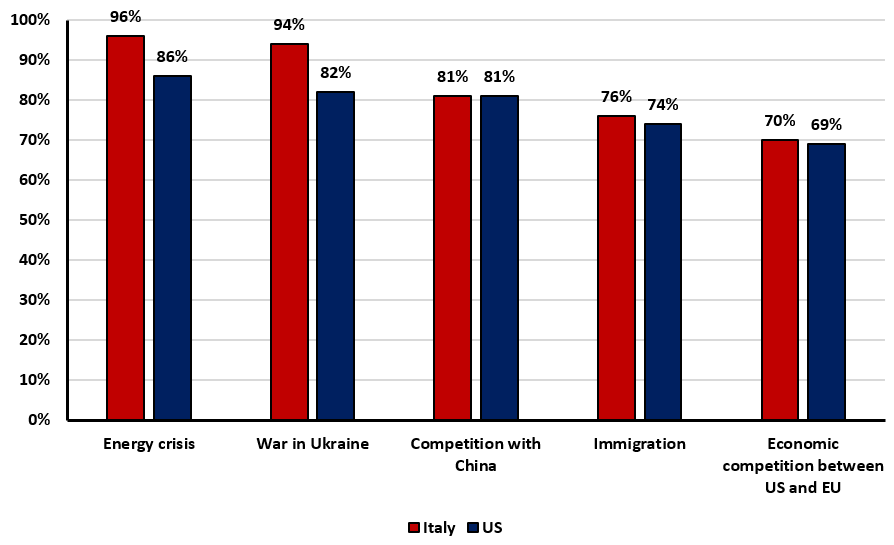
General orientations on international affairs
While both Italians and Americans think that “economic power is becoming more important than military power,” they differ in their views of the role of military power. 83% of Italians think that the role of economic power is becoming more important, and 79% of Americans think the same. Among Americans, 65% believe that war is necessary to achieve justice in the international system while only 31% of the Italian sample believes that war is necessary in some circumstances. 66% of Italians believe that Europeans are too concerned with their own affairs and do not take responsibility for the international system. This view is shared by 59% of the Americans.
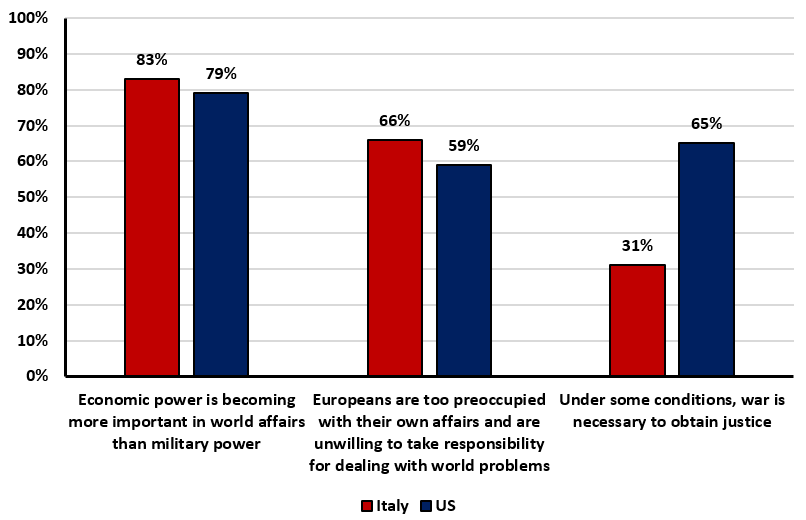
The Transatlantic Community
63% of Italians and Americans have a positive opinion about NATO. Additionally, both Italians and Americans believe that Europe should develop its military strength as a pillar of NATO: an absolute majority of 52% and 53% of Italian and American respondents, respectively, think so. 36% of Italians believe that European defense will make NATO obsolete; among Americans, this percentage drops to 30%. Conversely, compared with Italians, more Americans believe that NATO is sufficient to ensure the security of Europe (39% versus 34% among Italians). Almost half of the Italian sample (49%) believes that NATO is a tool by the United States to control European ambitions in the world. The percentage of Americans is considerably lower (35%).
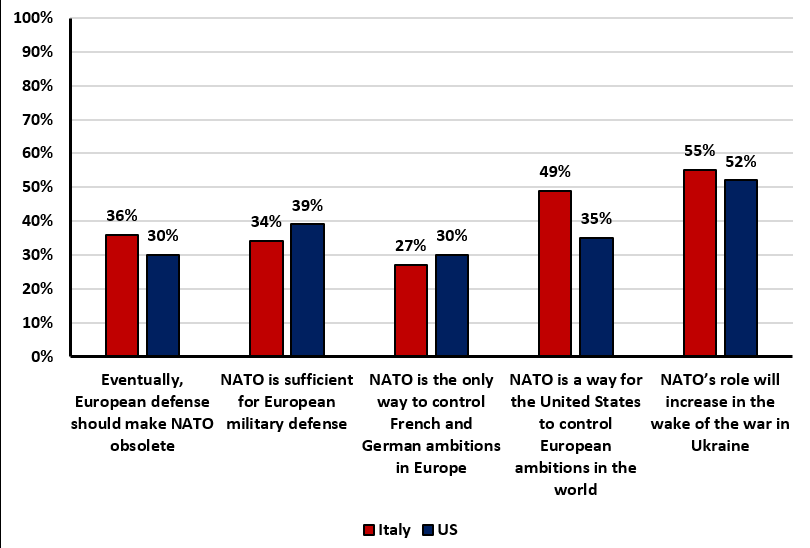
Only 6% of the Italian respondents believe that the United States should remain the only superpower. This proportion increases to 37% among American citizens. Instead, 41% of Italian respondents believe that the European Union should become a superpower like the United States; among American respondents, the proportion of supporters of this option is almost halved (24%).
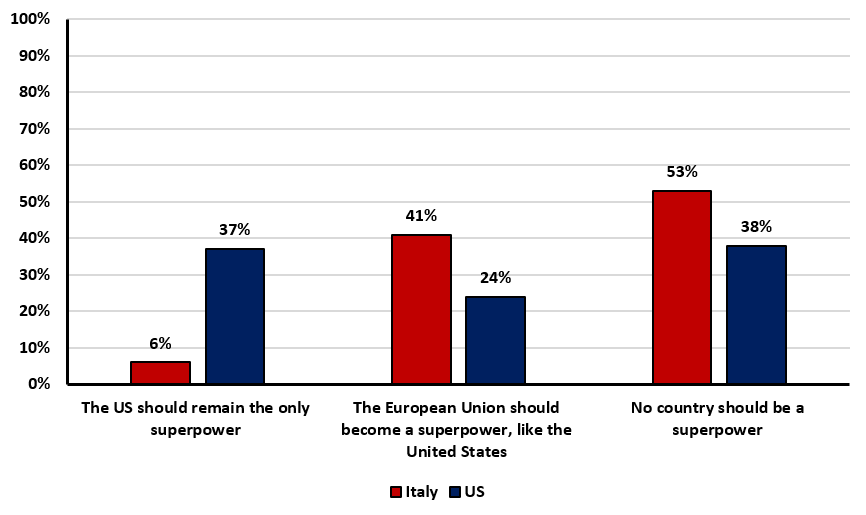
Mutual US-Italy relations
24% of Italians believe that the security partnership between the EU and the USA should become closer; this proportion significantly increases by 13 percentage points among Americans (37%). Instead, 39% of Italians believe that the EU should have a more independent approach from the USA, compared to the 21% recorded in the American sample.
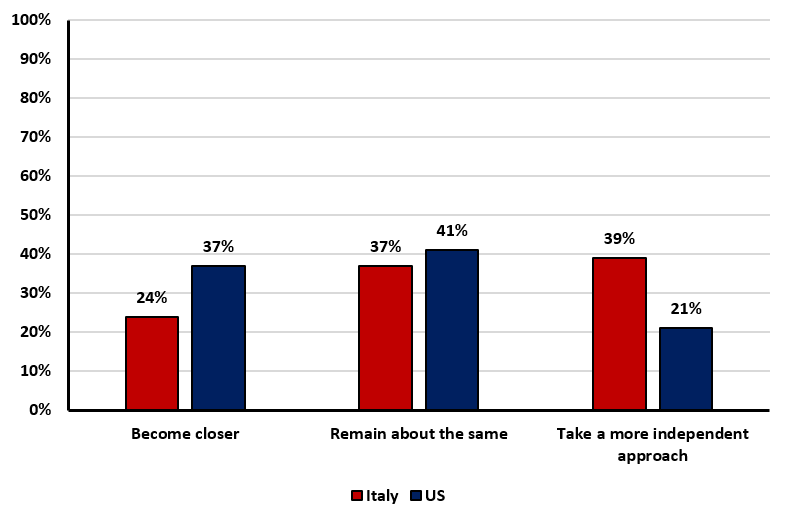
60% of Italians believe that the goal of European defense should be to achieve greater autonomy from the USA. However, only 24% of Americans think so.
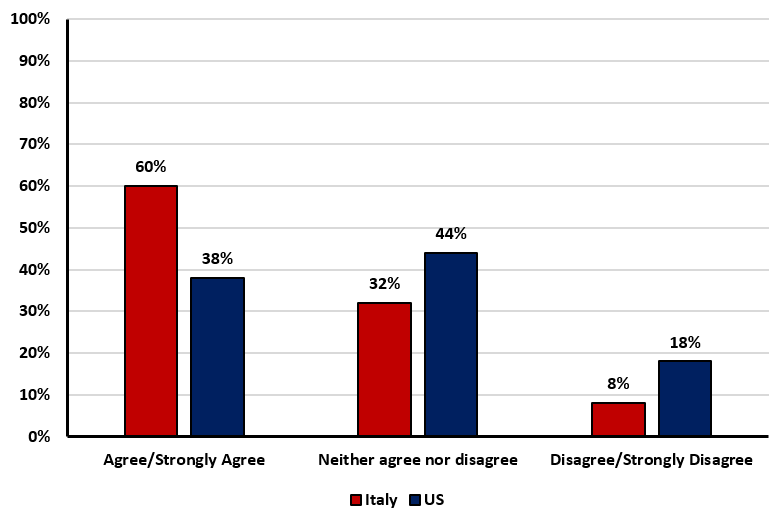
The main goal of European defense should be to achieve greater autonomy from the United States
Ukraine
The opinions of Italians and Americans on supplying weapons to Kyiv are quite distant: 46% in favor in Italy, and 71% in favor in the US. There is less distance on sanctions against Moscow: 68% for Italy and 78% for the USA.

(% agree/strongly agree)
The Americans are much more in favor of Ukraine joining NATO and the EU than Italians. An absolute majority of Americans (56%) would support Ukraine joining both parties. Among Italians, the share of those who would support both applications drops sharply to 36%.
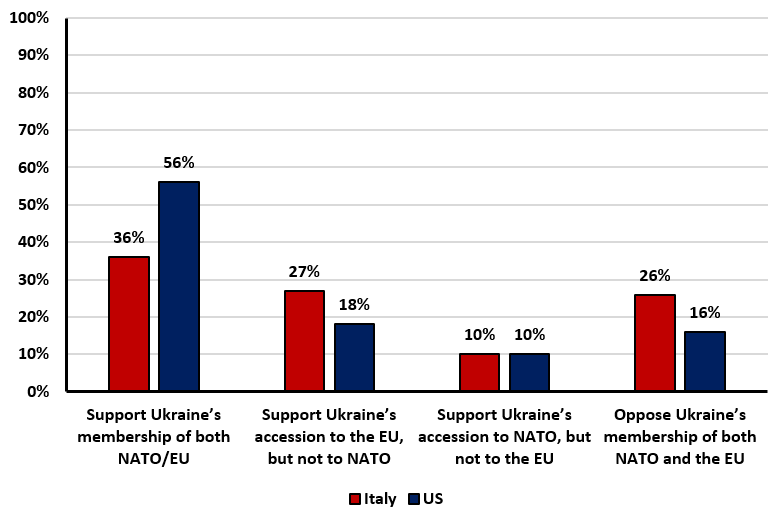
Americans are more optimistic about the possibility of Ukraine winning the war, while a plurality of Italians think that the war will end with a compromise in which no one will win. 32% of the Italians think Russia will win; 24% of Americans think the same.
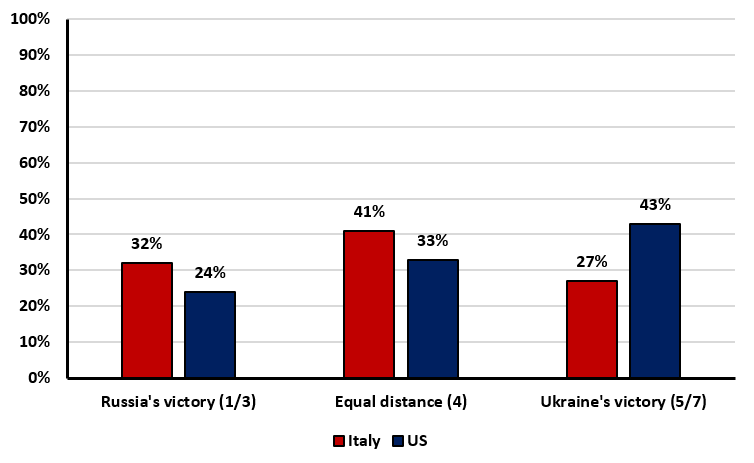
How do Italians and Americans perceive one another?
Italians and Americans agree that Europeans and Americans are socially and culturally different; while 71% of Italians think so, this proportion slightly increases among Americans (75%).
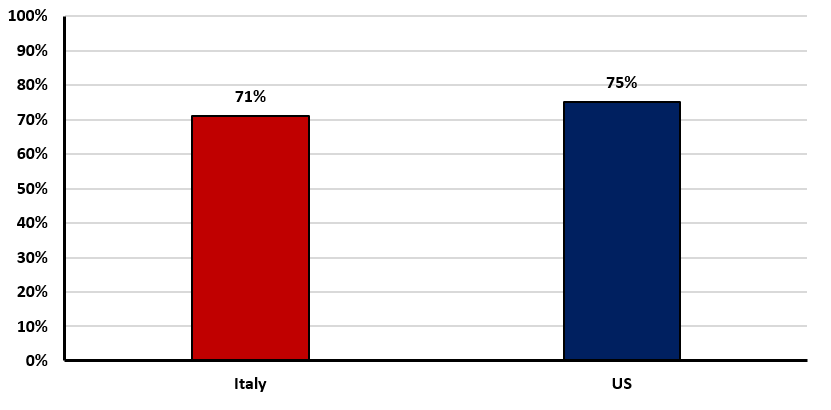
(% strongly/somewhat agree)
However, while only 44% of the Italians and 45% of the Americans think that their country “shares a close cultural relationship with” the other, more Italians think that Italy shares a close economic and military relationship with the US than Americans think with Italy.
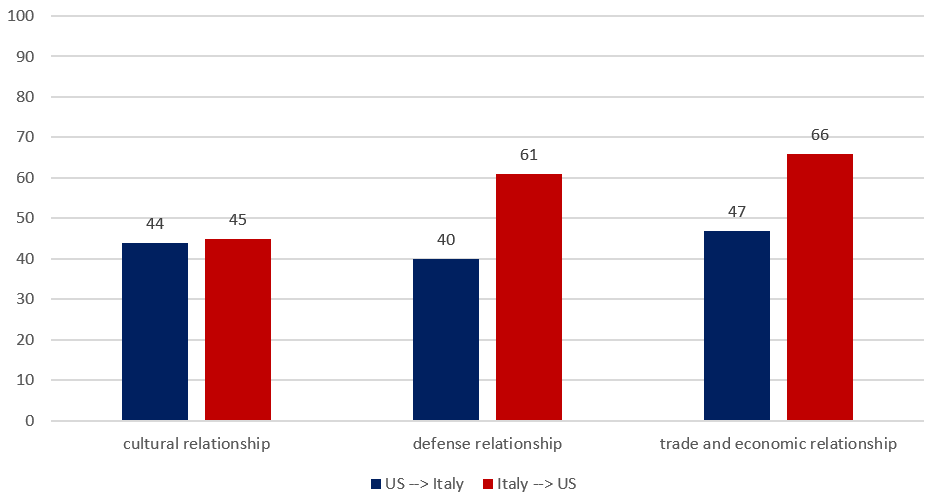
When invited to say which characteristics each associates with the other, some interesting differences emerge between Italians and Americans. They both agree (56%) that the other is “democratic,” but for other characteristics there are significant differences. Italians are perceived as more peaceful, tolerant, pro-environment, and hard-working by Americans than Americans are by Italians. On the contrary, Americans are perceived as more optimistic, greedy, arrogant, and violent by Italians than Italians by Americans.

When asked about a set of characteristics, Italians and Americans again appear to have different perceptions of the mutual points of strength and of weakness. Italians are more likely to say that Americans excel in science and technology, sports, and creativity, while Americans are more likely to think that Italians have a richer historical and cultural heritage. Similar percentages agree that the two countries are interesting in cultural terms and have natural beauty.

Italians and Americans both agree that the US and Italy are good places to study, but Americans tend to think better of Italy than Italians of the US on other characteristics. 58% of Americans think that Italy has a high quality of life, while 43% of Italians think the same of the US. 53% of Americans think Italy is a country in which rights are respected against 28% of Italians who think the same of the US. Interestingly, 40% of Americans think Italy is “competently and honestly governed,” while only 27% of Italians think the same of the United States.

When Americans are asked to assess Italy in comparison to other developed nations on a set of issue areas (armed forces, technology, universities, entertainment, standard of living, healthcare, food), no more than 40% think that Italy is the best. The only area in which 62% of Americans think Italy is excellent is in the food sector. Only 24% think of Italy as the best in the military sector. On the contrary, in many sectors, Italy thinks the US is the best (namely in the military, technology, universities, and entertainment). More Americans think the Italian healthcare system is among the best than Italians think of US healthcare.
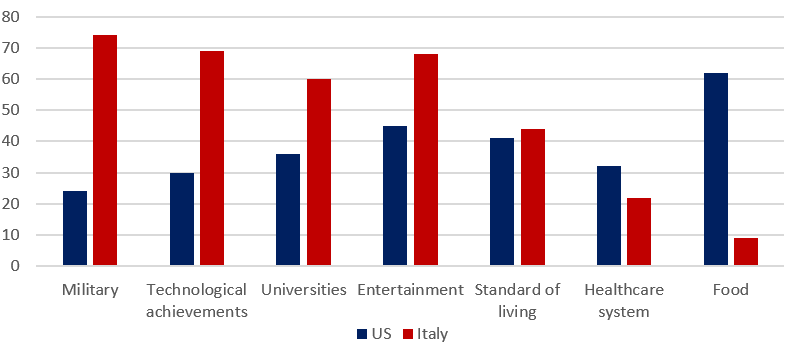
In line with the previous data, more Americans think that Italian food is healthy (69%) than Italians think American food is healthy (13%). In part related to this, almost one-third (29%) of Italians have never eaten fast food, and only 13% of Americans have never eaten in an Italian restaurant.
71% of Americans and 76% of Italians had never visited Italy and the US, respectively. Among the one-third who had, almost 50% of Italians and 40% of Americans visited the other only once in their lives.

Read also:
Il legame americano
Il miracolo di De Gasperi
Gli USA e il mondo: una nuova globalizzazione
Methodological note and authors
The survey, commissioned by Aspen Institute Italia, was conducted by the Laboratory for Political and Social Analysis (LAPS) of the Department of Social, Political, and Cognitive Sciences (DISPOC) of the University of Siena between January 23 and February 7, 2023. During the survey period, a sample of 1510 individuals of Italian nationality and 1505 individuals of US nationality aged 18 years or older were interviewed. This sample was selected from an opt-in online panel held and managed by CINT. For the extraction of the sample, a stratified sampling method was used based on sex, age, class, area of residence, and level of education, according to the parameters of the Italian and US adult population. The survey was self-administered using the CAWI (Computer-Assisted Web Interviewing) method. The data presented in this report have been further weighted to best reflect the socio-demographic characteristics (gender and age group, area of residence, and level of education) of the adult populations of the two countries. This report was written by Davide Angelucci and Pierangelo Isernia (University of Siena). The field survey was conducted by Rossella Borri (LAPS, University of Siena).
